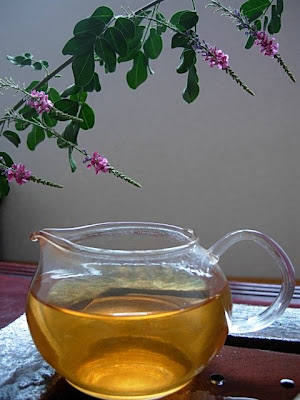
Bowl Number One by Jung Jum Gyo is the pricey piece. It displays many characteristics of an excellent chawan.
Firstly, the way in which the glaze sits on the bowl is absolutely beautiful. It is an excellent example of the method of applying glaze in drizzled little blobs wherein the clay underneath can peek through. This technique looks simple but is actually quite hard to master. One can best see this artistic element near the foot of the chawan where bloby glaze just barely covers the clay beneath.
Secondly, the cracking of the glaze inside the bowl is quite beautiful in this piece. The shallow of the bowl contains many fine dark cracks but as one's eyes move up the inside wall to the lip of the bowl the cracks slowly and gradually fade away before disappearing. This technique is also difficult to master in such a balanced, natural way.
Thirdly, the foot of this bowl conveys a sense of natural beauty, or 'wabi sabi' as Toki put it. The light glaze naturally blends, blotches, and fuses with the exposed clay in a way that is elegantly natural, far from jarring. It's four pieces supporting the bowl are extraordinarily thin. The swirling center appears pursed and cracked. This technique requires a skillful combination of intuitive glazing as well as appropriate firing. This piece was likely pushed to its limit under high heat in the kiln. If the heat in the kiln was too hot the four thin pieces would crack, if too low the cracked and pursed look could not be created. So, as you can see, this technique is also quite hard to master.
Fourthly, this piece conveys an overall naturalness to it that is especially prized by the Japanese and Koreans. The pale whiteish-pink colour, the form of the bowl, it's etchings, the way the glaze sits on the bowl, the elements of the foot all reflect a peaceful naturalness.

Bowl Number Two is also a excellent piece by
Kim Kyoung Soo. The cracking of the glaze is particularly wonderful in this piece, if not a little overdone. Its glaze is also thickly applied and shiny, a characteristic of Kim Kyoung Soo's style. It's etching pattern is also quite intricate perhaps the best of the three and the colour subtle and natural with pink softly laying with creamy white. Such a beautiful piece.

Bowl Number Three by
Kim Jeong Pill is a very interesting piece. It is probably the most eye catching and flamboyant of the three, the dark effect seen in the clay creating a stark contrast with the light glaze. The shallow of the bowl contains a beautiful swirl that also plays with the fine swirling brushed on technique found on the inside walls of the bowl. The beautiful circular pink flowering technique that is found on this piece characterizes most of Kim Jeong Pill's works.
Its foot is perhaps the most interesting feature of this bowl. The foot is glazed in such a way that the edges and bottom of the four pieces supporting the bowl are unglazed but slowly transition to ghostly white glaze accumulating in a swirling button. Its four pieces that support the bowl are all of different size and shape but yet appropriately support the bowl and create a sense of motion and change, exactly what this bowl is trying to convey. Although this bowl is stunning, it lacks the elements and feeling, subtlety and naturalness, found in traditional gimhae style bowls.
Thanks again for your wonderful commentary on these beautiful pieces. One hopes to do this again soon.
Peace





















































